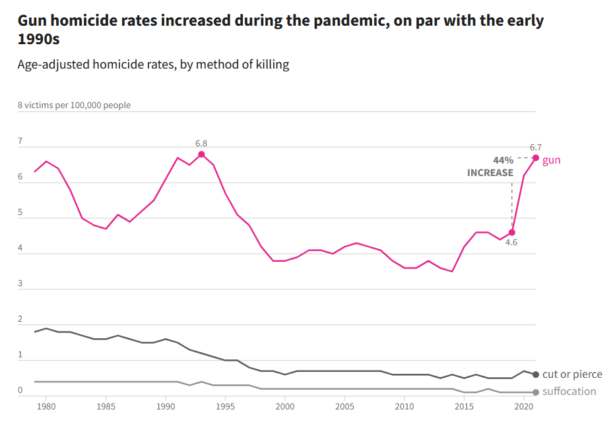According to a recent report, firearm homicide rates in the United States increased by 44 percent during the pandemic—after having declined steadily since the early 1990s.
The report was published by USAFacts, a nonpartisan, nonprofit initiative that aims to present data collected from a variety of government agencies in an accessible and easy-to-understand format.
The report describes firearm homicides as having rocketed by 44 percent between 2019 and 2021—from 4.6 victims per 100,000 people in 2019 to 6.7 per 100,000 in 2021. The rates fell just short of the 1993 homicide peak, when 6.8 people per 100,000 were killed by firearms.
In contrast, however, homicides committed using knives or by strangulation—the next-most-common methods of killing—decreased by 17 and 33 percent, respectively.

The number of active shooter events doubled between 2019 and 2021, but the number of deaths involved remained largely unchanged. In 2021, 103 victims were killed in active shooter events, accounting for about 0.5 percent of the homicides reported by the CDC that year.
The two main sources of homicide statistics used by the USAFacts report are the CDC and the FBI.
The CDC’s mortality data is the most complete, the report said, as it is compiled from death certificates collected from all 50 states.
The data from the FBI comes from its National Incident-Based Reporting System (NIBRS), which relies on local police departments to file homicide statistics. However, in 2021, only 63 percent of local police departments submitted their data to the NIBRS due to “technological and cost-related challenges,” USAFacts said.
The FBI tracks both active shooter events and mass killings (pdf). The agency uses an expanded definition of an active shooter event to include an individual or individuals “actively engaged in killing or attempting to kill people in a confined and populated area,” as well as those occurring outside.
Mass killings are defined as instances where three or more people are killed—but do not include the assailant.
Black Communities Experience Biggest Rise
According to police reports, 20 percent of firearm-related homicides occurred during an argument, 4 percent were the result of domestic violence, and 3 percent resulted from drug dealing. Less than two percent were related to gang violence, the report said. In the majority of cases (55 percent), the circumstances that led to the homicides are listed as unknown.
“Black, non-Hispanic people and Hispanic people had the sharpest increases in homicide rates from 2019 to 2021,” the report stated, with black people experiencing a firearms homicide rate of 29.9 victims per 100,000—a jump of 49 percent between 2019 and 2021. The firearms homicide rate for black Americans was 14 times that of whites, with black firearm homicides growing faster than for any other race.
Native Americans and Alaska natives saw a 22 percent increase, whites a 29 percent increase, and Asians a 20 percent increase.
Homicide rates tended to be slightly higher in red states, which USAFacts attributes to more lenient gun policies.
The report did not point to the pandemic lockdowns as a cause for the steep increase in homicide rates, despite the reported worldwide surge in domestic violence during the lockdowns—which researchers say had a considerable effect on many people’s mental health.

